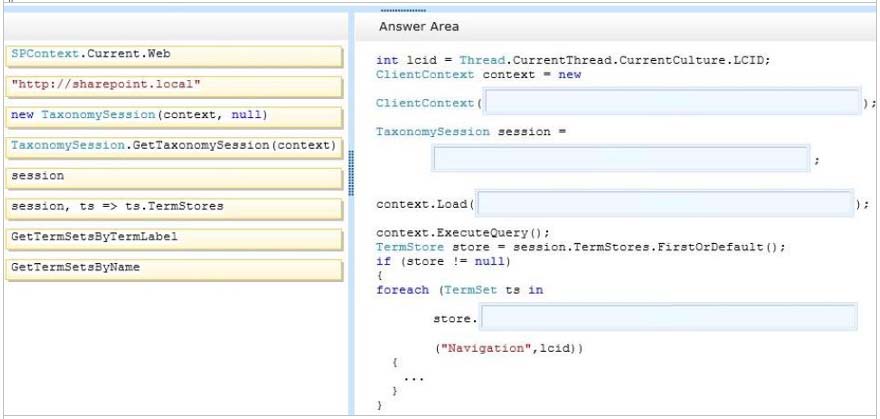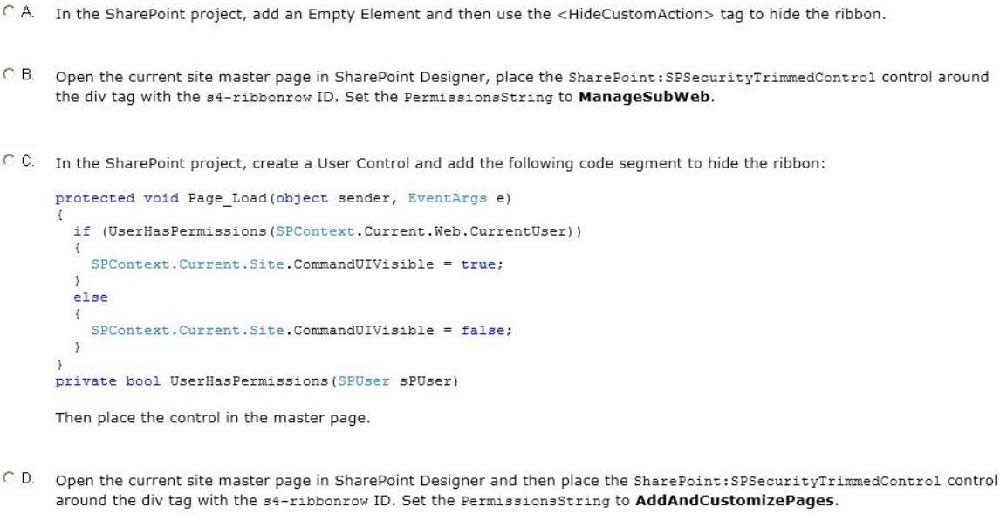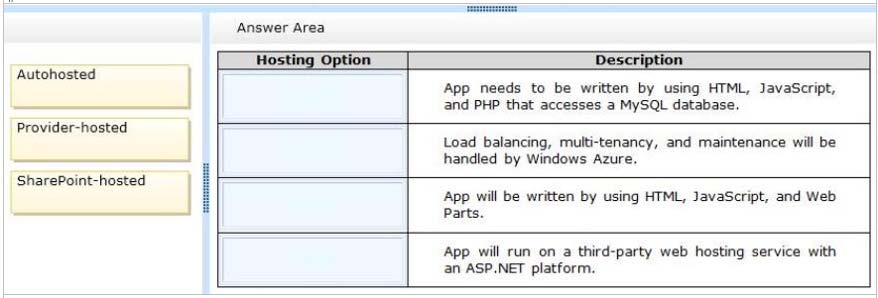Microsoft 70-488 Exam Practice Questions (P. 4)
- Full Access (79 questions)
- Six months of Premium Access
- Access to one million comments
- Seamless ChatGPT Integration
- Ability to download PDF files
- Anki Flashcard files for revision
- No Captcha & No AdSense
- Advanced Exam Configuration
Question #16
DRAG DROP -
You create an Enterprise Content Management (ECM) project. You write .NET client-side object model (CSOM) code to create a navigation term set in an existing term store to use in a taxonomy-based navigation.
You need to complete the code to get a reference to the term store.
How should you complete the relevant code? (To answer, drag the appropriate code segment to the correct location or locations in the answer area. Each code segment may be used once, more than once, or not at all. You may need to drag the split bar between panes or scroll to view content.)
Select and Place:

You create an Enterprise Content Management (ECM) project. You write .NET client-side object model (CSOM) code to create a navigation term set in an existing term store to use in a taxonomy-based navigation.
You need to complete the code to get a reference to the term store.
How should you complete the relevant code? (To answer, drag the appropriate code segment to the correct location or locations in the answer area. Each code segment may be used once, more than once, or not at all. You may need to drag the split bar between panes or scroll to view content.)
Select and Place:

Correct Answer:

*Box 1:
Example: //open context -
using (ClientContext context = new ClientContext("http://sharepoint.local")) etc.
* Example (box 2-3)
private void CreateColorsTermSet(string siteUrl)
{
ClientContext clientContext = new ClientContext(siteUrl);
TaxonomySession taxonomySession = TaxonomySession.GetTaxonomySession(clientContext); clientContext.Load(taxonomySession, ts => ts.TermStores.Include( store => store.Name, store => store.Groups.Include( group => group.Name
)
)
);
clientContext.ExecuteQuery();
Box 4: GetTermSetsByName -
SP.Taxonomy.TaxonomySession.getTermSetsByName Method
Gets all TermSet objects from all TermStore objects that have a name in the specified language.
Reference: Managed metadata and navigation in SharePoint 2013

*Box 1:
Example: //open context -
using (ClientContext context = new ClientContext("http://sharepoint.local")) etc.
* Example (box 2-3)
private void CreateColorsTermSet(string siteUrl)
{
ClientContext clientContext = new ClientContext(siteUrl);
TaxonomySession taxonomySession = TaxonomySession.GetTaxonomySession(clientContext); clientContext.Load(taxonomySession, ts => ts.TermStores.Include( store => store.Name, store => store.Groups.Include( group => group.Name
)
)
);
clientContext.ExecuteQuery();
Box 4: GetTermSetsByName -
SP.Taxonomy.TaxonomySession.getTermSetsByName Method
Gets all TermSet objects from all TermStore objects that have a name in the specified language.
Reference: Managed metadata and navigation in SharePoint 2013
send
light_mode
delete
Question #17
Adventure Works uses a SharePoint publishing site to host their public-facing website at http://www.adventureworks.com. The website gives external users the ability to register and sign in to the site to buy Adventure Works products.
You notice that publicly registered users see the SharePoint ribbon.
You need to ensure that the SharePoint ribbon is available only to content authors and administrators.
What should you do?

You notice that publicly registered users see the SharePoint ribbon.
You need to ensure that the SharePoint ribbon is available only to content authors and administrators.
What should you do?

- AOption A
- BOption B
- COption C
- DOption D
Correct Answer:
D
If you designed a custom master page for your SharePoint 2010 and the ribbon is in your way, SharePoint has a built-in control that lets you hide it from anonymous users in few easy steps. Open and check-out your master page, find where your ribbon control starts or look for <WebPartPages:SPWebPartManager id="m" runat="Server"/>. Place this control below <Sharepoint:SPSecurityTrimmedControl runat="server" Permissions="AddAndCustomizePages">. Find where your ribbon control ends or look for <div id=s4-workspace> and place the closing control above it </SharePoint:SPSecurityTrimmedControl>. Save, check-in the master page and publish it to see the changes. From now on, only logged in users with the right permissions will be able to see the ribbon on the top.
Incorrect:
Not B: Permission should be set to AddAndCustomizePages not ManageSubWeb.
Reference: SharePoint, Hide the Ribbon from Anonymous Users http://www.topsharepoint.com/hide-the-ribbon-from-anonymous-users
D
If you designed a custom master page for your SharePoint 2010 and the ribbon is in your way, SharePoint has a built-in control that lets you hide it from anonymous users in few easy steps. Open and check-out your master page, find where your ribbon control starts or look for <WebPartPages:SPWebPartManager id="m" runat="Server"/>. Place this control below <Sharepoint:SPSecurityTrimmedControl runat="server" Permissions="AddAndCustomizePages">. Find where your ribbon control ends or look for <div id=s4-workspace> and place the closing control above it </SharePoint:SPSecurityTrimmedControl>. Save, check-in the master page and publish it to see the changes. From now on, only logged in users with the right permissions will be able to see the ribbon on the top.
Incorrect:
Not B: Permission should be set to AddAndCustomizePages not ManageSubWeb.
Reference: SharePoint, Hide the Ribbon from Anonymous Users http://www.topsharepoint.com/hide-the-ribbon-from-anonymous-users
send
light_mode
delete
Question #18
DRAG DROP -
You have an app named TaskManager published at http://sharepoint.contoso.com/apps.
You need to remove the app and ensure that users will no longer be able to use the app by using Windows PowerShell cmdlets.
What should you do? (To answer, drag the appropriate code segments to the correct location or locations in the answer area. Each code segment may be used once, more than once, or not at all. You may need to drag the split bar between panes or scroll to view content.)
Select and Place:
You have an app named TaskManager published at http://sharepoint.contoso.com/apps.
You need to remove the app and ensure that users will no longer be able to use the app by using Windows PowerShell cmdlets.
What should you do? (To answer, drag the appropriate code segments to the correct location or locations in the answer area. Each code segment may be used once, more than once, or not at all. You may need to drag the split bar between panes or scroll to view content.)
Select and Place:
Correct Answer:

* Get-SPAppInstance
Use the Get-AppInstance cmdlet to get a collection of app instances that are installed on an SPWeb object.
*Uninstall-SPAppInstance
Use the Uninstall-SPAppInstance cmdlet to uninstall an instance of an app. This cmdlet is required to be run before a migration process.
-------------EXAMPLE--------------
$instance = Get-SPAppInstance -AppInstanceId $instance.Id
Uninstall-SPAppInstance -Identity $spapp
This example uninstalls an instance of an app.
Reference: Uninstall-SPAppInstance

* Get-SPAppInstance
Use the Get-AppInstance cmdlet to get a collection of app instances that are installed on an SPWeb object.
*Uninstall-SPAppInstance
Use the Uninstall-SPAppInstance cmdlet to uninstall an instance of an app. This cmdlet is required to be run before a migration process.
-------------EXAMPLE--------------
$instance = Get-SPAppInstance -AppInstanceId $instance.Id
Uninstall-SPAppInstance -Identity $spapp
This example uninstalls an instance of an app.
Reference: Uninstall-SPAppInstance
send
light_mode
delete
Question #19
DRAG DROP -
You create SharePoint apps for multiple clients.
Each client has a unique environment with specific requirements.
You need to choose the appropriate hosting location for each app.
What should you do? (To answer, drag the appropriate hosting options to the correct description in the answer area. Each hosting option may be used once, more than once, or not at all. You may need to drag the split bar between panes or scroll to view content.)
Select and Place:
You create SharePoint apps for multiple clients.
Each client has a unique environment with specific requirements.
You need to choose the appropriate hosting location for each app.
What should you do? (To answer, drag the appropriate hosting options to the correct description in the answer area. Each hosting option may be used once, more than once, or not at all. You may need to drag the split bar between panes or scroll to view content.)
Select and Place:
Correct Answer:

Box 1, box 4: Provider-hosted apps
Provider-hosted apps for SharePoint include components that are deployed and hosted outside the SharePoint farm. They are installed to the host web, but their remote components are hosted on another server.
Box 2: Autohosted -
With auto-hosted apps all Windows Azure and Windows Azure SQL Database components are provisioned for you when the app is installed and the Windows
Azure Web Sites infrastructure handles load balancing and other important maintenance tasks for you.
Box 3: SharePoint-hosted -
SharePoint-hosted apps -
Start with the simplest option: SharePoint-hosted apps, or apps where all components are hosted on either an on-premises or Office 365 SharePoint farm.
Note: Apps in SharePoint -
SharePoint 2013 app model has three types of hosting model.
a. SharePoint Hosted Application.
b. Auto Hosted Application.
c. Provider Hosted Application.
Reference: Choose patterns for developing and hosting your app for SharePoint

Box 1, box 4: Provider-hosted apps
Provider-hosted apps for SharePoint include components that are deployed and hosted outside the SharePoint farm. They are installed to the host web, but their remote components are hosted on another server.
Box 2: Autohosted -
With auto-hosted apps all Windows Azure and Windows Azure SQL Database components are provisioned for you when the app is installed and the Windows
Azure Web Sites infrastructure handles load balancing and other important maintenance tasks for you.
Box 3: SharePoint-hosted -
SharePoint-hosted apps -
Start with the simplest option: SharePoint-hosted apps, or apps where all components are hosted on either an on-premises or Office 365 SharePoint farm.
Note: Apps in SharePoint -
SharePoint 2013 app model has three types of hosting model.
a. SharePoint Hosted Application.
b. Auto Hosted Application.
c. Provider Hosted Application.
Reference: Choose patterns for developing and hosting your app for SharePoint
send
light_mode
delete
Question #20
You must select an app model to deploy apps to an Office 365 small business tenant. The business logic of the apps is located in a remote web application.
What should you do?
What should you do?
- ACreate a SharePoint-hosted app. Implement the business logic by using JavaScript.
- BDevelop provider-hosted apps and integrate data sources with the business logic by using OData.
- CDeploy the business logic to the host web by using a Full Trust SharePoint solution.
- DDevelop an OData service provider infrastructure and publish the provider to the _layouts directory.
Correct Answer:
B
Provider Hosted Application -
Provider hosted apps are also a part of cloud hosting model, where app can be hosted on any remote web platform such as IIS server. And these apps are made available on deploying it on cloud i.e. using SharePoint online, Office365 site, or windows azure in case of Auto hosting.
It interacts with SharePoint 2013 by using one of the SharePoint client object models or its REST/OData-based web service. Depending on the scenario it gains authorization to SharePoint data using either the SharePoint 2013 implementation of the OAuth standard or a JavaScript cross-domain library.
Note: Apps in SharePoint -
SharePoint 2013 app model has three types of hosting model.
a. SharePoint Hosted Application.
b. Auto Hosted Application.
c. Provider Hosted Application.
Incorrect:
Not C: When you use the full-trust execution model, you deploy your assemblies to the global assembly cache on each Web front-end server and application server in the server farm. The SharePoint Web application process loads the assembly from the global assembly cache and your code runs with full trust--in other words, it runs without any code access security restrictions.
Reference: Step by step create provider hosted application using SharePoint 2013
B
Provider Hosted Application -
Provider hosted apps are also a part of cloud hosting model, where app can be hosted on any remote web platform such as IIS server. And these apps are made available on deploying it on cloud i.e. using SharePoint online, Office365 site, or windows azure in case of Auto hosting.
It interacts with SharePoint 2013 by using one of the SharePoint client object models or its REST/OData-based web service. Depending on the scenario it gains authorization to SharePoint data using either the SharePoint 2013 implementation of the OAuth standard or a JavaScript cross-domain library.
Note: Apps in SharePoint -
SharePoint 2013 app model has three types of hosting model.
a. SharePoint Hosted Application.
b. Auto Hosted Application.
c. Provider Hosted Application.
Incorrect:
Not C: When you use the full-trust execution model, you deploy your assemblies to the global assembly cache on each Web front-end server and application server in the server farm. The SharePoint Web application process loads the assembly from the global assembly cache and your code runs with full trust--in other words, it runs without any code access security restrictions.
Reference: Step by step create provider hosted application using SharePoint 2013
send
light_mode
delete
All Pages
